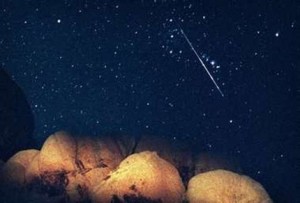Our hot August night skies are seared with serendipity in this year of 2012. We have the good fortune of gazing up into a full moon twice in this same month; an event that only occurs every two –three years. Friday August 31, 2012 will mark the second full moon of this month. Check our blog https://www.sonoranresorts.mx/?p=5682 for details on this.
You don’t have to wait until the 31st to see a spectacular event in the August night sky, however. The annual Perseid meteor shower begins its most illustrious sequence in the wee hours of Saturday August 11. In case you’re up late, that’s just a couple of hours from  this posting. Don’t worry if you don’t read this until Saturday morning. You haven’t missed the best show of this shower, which will get even better between 2:00AM and just before dawn on Sunday and Monday when the darkest part of the northeastern sky will be streaked with an average of 50 meteors an hour.
this posting. Don’t worry if you don’t read this until Saturday morning. You haven’t missed the best show of this shower, which will get even better between 2:00AM and just before dawn on Sunday and Monday when the darkest part of the northeastern sky will be streaked with an average of 50 meteors an hour.
We’re even luckier to have a thin waning crescent moon in the predawn hours of these three nights which will be steadily floating past the other two of the three brightest globes, Jupiter and Venus. In its waning state the crescent moon won’t affect visibility of the meteor show. In fact, you don’t need any special equipment; you don’t even have to know where the constellation Perseus is located. This is the constellation from which the meteors get their name because if you trace their path backward it seems like they’re originating from that constellation. These annual meteor showers are actually made up of dusty debris from the Comet ![MP900178735[1] MP900178735[1]](https://www.sonoranresorts.mx/wp-content/uploads/2012/08/MP9001787351-150x150.jpg) Swift-Tuttle as the debris make fiery collisions into the Earth’s upper atmosphere when our orbit crosses the orbital path of that Comet each year; each year since about the 8th century.
Swift-Tuttle as the debris make fiery collisions into the Earth’s upper atmosphere when our orbit crosses the orbital path of that Comet each year; each year since about the 8th century.
Although this light show is best seen in the Northern Hemisphere sky, since the Perseus radiant rises steadily over night, by 2:00 AM, maybe earlier, looking toward the northeast you’ll be seeing more and more meteor activity that will continue until just before dawn when the sky is the darkest. Keep in mind that the meteor showers can be seen from any direction due to the scattered, streaking nature of the meteor particles. It’s just that you see a larger number on average looking toward the northeast after midnight.
For more information: http://earthsky.org/tonight/perseid-meteor-shower-to-peak-this-weeend
Top Photo courtesy of earthsky.org
Happy gazing while the stars are blazing!
This blog is powered by www.sonoranresorts.mx , Jim Ringquist, Director of sales and marketing.

